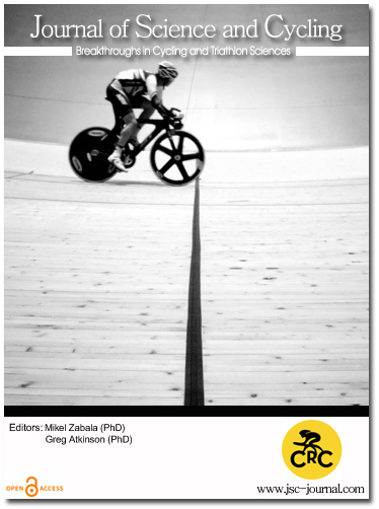The effects of different strength training regimes on cycling performance
Abstract
Background: There is conflicting literature on the effect of strength training on road cycling performance, with the most recent literature showing a positive effect with maximal strength training (Rønnestad & Mujika, 2013: Scan J Med Sci Sports, Aug 5. doi: 10.1111/sms.12104). Most of these studies are flawed in that they compare strength training added to an endurance program with only endurance training, while many elite cyclists already use some sort of strength training in their program, mainly sub maximal or explosive resistance training. Purpose: To determine if maximal strength training is superior to sub maximal strength training, we compared the effects of maximal and sub maximal strength training programs on cycling performance in young elite cyclists, while keeping the number of strength training sessions equal.Methods: The programs consisted of maximal (front squats, squat jumps, 1 arm dumbbell press, box steps, Romanian deadlifts (week 1-4) and squat (90o), box jumps, 1 arm dumbbell pull, one legged squat and deadlift from knee height (week 6-9), 3-5 sets of 3-6 RM) or sub maximal strength training (half squat, squat jumps, 1 arm dumbbell press, leg press (1 leg), Romanian deadlift (week 1-4) and half squat, hip flexion, bent over row, box steps and calf lifting (week 6-9), 3 sets of 8-12 repetitions). Strength training was performed twice a week and was concurrent to cycling endurance training, which was kept similar for both groups, though individualized. Seventeen male cyclists were assessed for mean maximal power output over 5, 15, 30, 60, 240 and 600 s (Quad et al., 2010: Int J Sports Med, 31(6), 397-401) 3-7 days before and after the first and last strength training. Precision of the estimate was used to determine probabilities of practical significance.
Results: Between-group differences for all cycling tests were found unclear, except at 15 s mean maximal power (4.2%; ±3.5% likely) and at 30 s mean maximal power (7.6%; ±5.6% very likely), where the maximal strength group performed worse (Table 1).
Discussion: Maximal strength training was not superior over sub maximal strength training in these elite cyclists. A possible explanation for the discrepancy with recent studies is that the participants in our study were already used to strength training, while in these recent studies the participants had no experience with strength training and the strength training was added to their cycling training, increasing the amount of training time for the experimental groups (e.g. Rønnestad et al., 2010: Eur J Appl Physiol, 110(6), 1269-1282). Coming from relative rest, the increase in endurance performance in both groups show that both training programs are effective, although the maximal training group decreased their 15 s and 30 s mean maximal power output, possibly due to detraining of the anaerobic glycolytic pathways, while the sub max group did maintain these pathways through the multiple efforts with short recovery.
Conclusion: No difference was found in increase in endurance performance in elite cyclists using maximal or sub maximal strength training, suggesting that sub maximal strength training is sufficient and effective for road cycling performance.
Downloads
Published
How to Cite
Issue
Section
Copyright (c) 2014 Journal of Science and Cycling

This work is licensed under a Creative Commons Attribution-NonCommercial 4.0 International License.
Authors contributing to Journal of Science and Cycling agree to publish their articles under a Creative Commons CC BY-NC-ND license, allowing third parties to copy and redistribute the material in any medium or format, and to remix, transform, and build upon the material, for any purpose, even commercially, under the condition that appropriate credit is given, that a link to the license is provided, and that you indicate if changes were made. You may do so in any reasonable manner, but not in any way that suggests the licensor endorses you or your use.
Authors retain copyright of their work, with first publication rights granted to Cycling Research Center.






